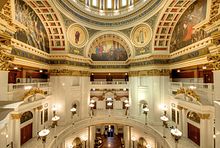Pennsylvania State Capitol
The building was designed by architect Joseph Miller Huston in 1902 and completed in 1906 in a Beaux-Arts style with decorative Renaissance themes throughout.
The Pennsylvania State Capitol is often referred to as a "palace of art" because of its many sculptures, murals, and stained-glass windows, most of which are Pennsylvania-themed or Pennsylvanian-made.
Andrew Hamilton and William Allen were authorized to acquire land in Philadelphia for Pennsylvania's first statehouse, now known as Independence Hall, which began construction in 1732 and was completed in 1753.
John Harris Jr. offered to give 4 acres (2 ha) and 21 square perches (5,717 ft2; 531 m2) of land near the banks of the Susquehanna River in central Pennsylvania to the state, provided that it be eventually used as the site of the capital.
[9] The legislature voted in 1810 to relocate the capital again and moved the seat of government to Harrisburg in October 1812 onto the land originally given by Harris a decade earlier.
[16] newly elected 16th President Abraham Lincoln visited the capitol in February 1861 as president-elect while journeying from his home in Illinois to be sworn-in at Washington, and then his body lay in state there during the sad long train trip back to Springfield for burial, after his April 1865 assassination.
[17] Pennsylvania's collection of American Civil War (1861-1865) battle flags, which were accumulated in 1866, was moved from the nearby State Arsenal to the second floor of the capitol in 1872.
[21] There were soon demands that the capital be relocated to Pittsburgh or Philadelphia; the legislature quickly appropriated money to build a new capitol in Harrisburg.
[22][23] Governor Daniel H. Hastings opted for a pay-as-you-go policy to allow the construction costs to be spread over multiple annual budgets.
The legislature met in the finished building, which they had deemed complete, even though it was an "unadorned, unfinished, several-story brown brick structure that looked like a factory" on January 3, 1899.
President Theodore Roosevelt, who had arrived earlier that morning by a special train to deliver a speech and tour the new capitol, declared it "the handsomest building I ever saw.
"[30] The Pennsylvania, Northern Central, Reading, and Cumberland Valley railroads each ran special trains to accommodate the crowds traveling to and from Harrisburg for the dedication.
[34] William H. Berry was elected in 1906, shortly after the dedication, to the office of State Treasurer on a reform "fusion ticket".
[35] Berry began investigating the costs of the capitol project and brought its $13 million pricetag to the attention of the public.
Part of the reason for the discrepancy was Pennsylvania's "over-elaborate" and sometimes "unintelligible" method of "ordering and purchasing supplies, equipment [and] furnishings, commonly called the 'per-foot rule' .
"[40][41] The Superintendent of Public Ground and Buildings James Shumaker and Auditor General William Preston Snyder were also convicted.
[45] Brunner planned a bridge to cross the railroad tracks and connect the capitol with the highest point in the city at 13th Street.
[2] Beginning in 1981, highly regarded historic preservation architect, Hyman Myers, of the Philadelphia architecture firm, Vitetta Group, oversaw the restoration of the capitol building.
[52] The statue atop the capitol dome was removed for restoration via helicopter in the summer of 1998, being returned in September of the same year.
[58] The dome features bright green Ludowici tiles and weighs 26,000 short tons (24,000 t) and was architecturally inspired by St. Peter's Basilica in Vatican City.
Busts of people who were important in the construction of the capitol, like Governor Pennypacker, Boies Penrose, and Matthew Quay, decorate the edges of the doors.
Arnold Brunner designed the layout of the grounds, which originally totaled only 15 acres (6 ha) from the land Harris and Maclay gave to the state.
Edwin Austin Abbey painted four allegorical medallions around the base of the capitol dome, detailing the "four forces of civilization": Art, Justice, Science, and Religion.
Four lunette murals were also painted by Abbey and "symbolize Pennsylvania's spiritual and industrial contributions to modern civilization.
[65] Mercer produced 16,000 sq ft (1,500 m2) of tile, which includes "377 mosaics, representing 254 scenes, artifacts, animals, birds, fish, insects, industries and workers from Pennsylvania history".
[65] The interiors of the rotunda and the dome are inscribed with a quote from William Penn made upon the foundation of the Commonwealth of Pennsylvania:[66] There may be room there for such a holy experiment.
Van Ingen created the fourteen circular, stained-glass windows in the House Chamber,[68] and Abbey painted its five murals.
All the walls and door frames of the Senate Chamber of the Capitol Building in Harrisburg, Pennsylvania are done in a variety of Irish Jade marble.
The complex and greater area is protected full-time by the Pennsylvania Capitol Police—its dedicated law enforcement agency—as well as the Harrisburg Bureau of Police, which patrols the entire city.
It was built partially underground, such that the tallest point on the East Wing barely reaches the first floor of the capitol.







